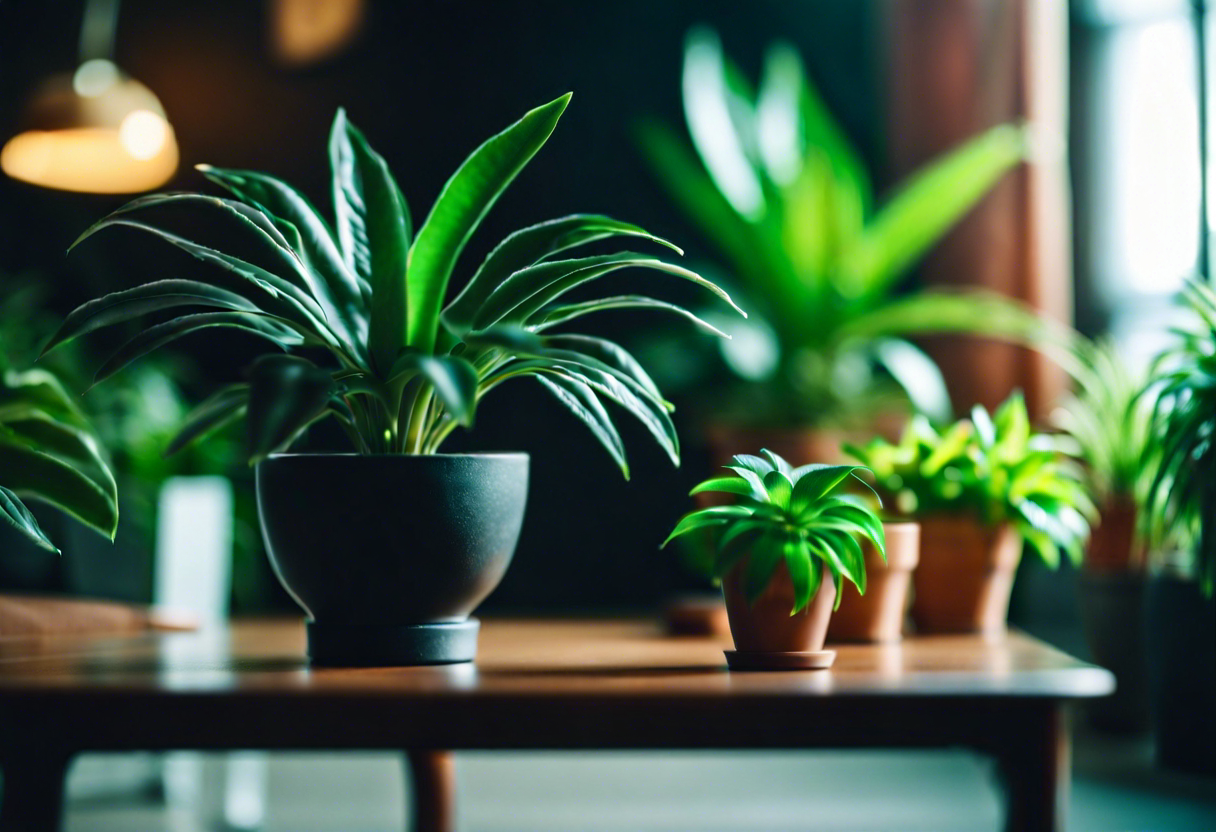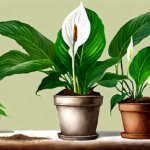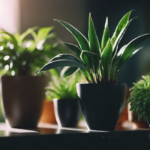Top 10 Best Indoor Plants for Living Room
Having indoor plants in your living room not only adds a touch of natural beauty but also provides numerous benefits for your overall well-being. Indoor plants can enhance the aesthetic appeal of your space while also improving air quality and reducing stress levels. However, choosing the right indoor plants for your living room may seem overwhelming with a wide variety of options available. To help you narrow down your choices, here are the top 10 best indoor plants for your living room:
-
Snake Plant (Sansevieria): This popular indoor plant is known for its ability to tolerate low light conditions and purify the air by removing toxins like formaldehyde and benzene. Snake plants come in different varieties, with long leaves that add a modern and elegant touch to your living room.
-
Fiddle Leaf Fig (Ficus lyrata): With its large, glossy leaves and tree-like appearance, the fiddle leaf fig is a statement-making plant that adds a tropical vibe to any living room. It thrives in bright, indirect light and requires regular watering.
-
Peace Lily (Spathiphyllum): If you’re looking for a flowering indoor plant, the peace lily is an excellent choice. It features elegant white blooms and helps improve air quality by removing common pollutants. It prefers medium to low light and thrives in slightly moist soil.
-
Spider Plant (Chlorophytum comosum): Spider plants are easy to care for and perfect for beginners. They have long, arching leaves with white stripes and produce small offshoots called spiderettes. Spider plants thrive in bright, indirect light and can tolerate a wide range of conditions.
-
ZZ Plant (Zamioculcas zamiifolia): The ZZ plant is a popular choice for those seeking a low-maintenance indoor plant. It has glossy, dark green leaves that add a tropical touch to your living room. ZZ plants can tolerate low light and irregular watering, making them perfect for busy individuals.
-
Pothos (Epipremnum aureum): Pothos, also known as Devil’s Ivy, is a trailing indoor plant that is incredibly resilient. It comes in various colors and variegations, adding visual interest to your living room. Pothos can tolerate low light conditions and irregular watering, making it ideal for beginners.
-
Rubber Plant (Ficus elastica): With its large, shiny leaves, the rubber plant adds a bold and dramatic statement to your living room. It prefers moderate to bright indirect light and regular watering. The rubber plant is also an excellent air purifier.
-
Boston Fern (Nephrolepis exaltata): If you’re looking to add a touch of greenery and softness to your living room, the Boston fern is a perfect choice. It thrives in high humidity and indirect light, making it ideal for bathrooms and kitchens as well. Boston ferns require consistent moisture to thrive.
-
Dracaena (Dracaena marginata): Dracaena plants come in various varieties, including the popular dragon tree. They have long, slender leaves that come in different colors, adding a dramatic effect to your living room. Dracaenas can tolerate low light and irregular watering.
-
Chinese Evergreen (Aglaonema): Chinese Evergreen is a versatile indoor plant that comes in different shades of green, silver, and red. It thrives in low to medium light conditions and prefers consistently moist soil. Chinese Evergreen is also known for its air-purifying properties.
These top 10 best indoor plants into your living room will not only enhance the ambiance but also offer a host of benefits. Before bringing any plant home, ensure you understand its specific care requirements to help it thrive and brighten up your living space. Cheers to a greener and more vibrant living room!
Benefits of Having Indoor Plants in Your Living Room
Indoor plants not only enhance the aesthetic appeal of your living room but also bring numerous benefits to your overall well-being. The presence of greenery indoors can create a tranquil and relaxing environment, making your living space more inviting and refreshing. indoor plants in your living room can have several advantages, both for your physical and mental health.
One of the primary benefits of having indoor plants in your living room is improved air quality. Plants naturally release oxygen during the process of photosynthesis, which can help purify the air by removing harmful toxins and pollutants. This can greatly benefit individuals who suffer from respiratory issues or allergies, as it contributes to cleaner and fresher air within the living space.
In addition to improving air quality, indoor plants can also increase humidity in the room. Plants release moisture vapor through a process known as transpiration, which can help to combat dryness in indoor spaces, especially during the winter months when heating systems can cause the air to become dry. Increased humidity can prevent dry skin, dry throat, and other related discomforts.
Furthermore, indoor plants have been shown to have a positive impact on mental well-being. Their presence can help reduce stress levels and promote relaxation. Studies have indicated that being near plants can lower blood pressure and heart rate, leading to a calmer and more peaceful state of mind. This is particularly beneficial in a living room setting, where individuals often seek solace and relaxation after a long day.
Indoor plants in your living room can also improve your productivity and focus. Research has found that indoor plants can enhance concentration and memory retention, making them an excellent addition to home offices or study areas within the living room. The sight of greenery can stimulate the brain and increase cognitive function, ultimately leading to improved work or study performance.
Moreover, indoor plants can serve as natural mood boosters. Their vibrant colors and life-affirming presence can contribute to a positive and happy atmosphere within your living room. Being around plants has been shown to elevate mood and reduce symptoms of anxiety and depression. The beauty and serenity they provide can create a sense of well-being and harmony in your living space.
When selecting indoor plants for your living room, consider their light and humidity requirements, as well as your personal preferences for maintenance. Some popular choices include the spider plant, pothos, snake plant, and peace lily, all of which are known for their air-purifying qualities and easy care. With proper care and attention, these plants can flourish in your living room, offering you a myriad of benefits for years to come.
How to Choose the Right Indoor Plants for Your Living Room
Indoor plants are a great way to add a touch of greenery and life to your living room. Not only do they enhance the aesthetic appeal of the space, but they also provide numerous health benefits. However, with so many options available, it can be overwhelming to choose the right indoor plants for your living room. In this article, we will discuss some essential factors to consider when selecting the best indoor plants for your living room.
Lighting: One of the most crucial factors to consider when choosing indoor plants is the lighting conditions in your living room. Different plants have varying light requirements, so it is essential to select plants that can thrive in the available light. For instance, if your living room receives bright, indirect sunlight, plants like snake plants or ZZ plants are suitable options. On the other hand, if your living room has low light conditions, consider plants like pothos or peace lilies that can thrive in low-light environments.
Size and Space: Consider the size of your living room and the available space for placing indoor plants. If you have a spacious living area, you can opt for larger plants like fiddle leaf figs or palm trees as statement pieces. However, if you have limited space, consider smaller plants like succulents or air plants that can be placed on shelves or tabletops. Additionally, consider the overall aesthetic of your living room and choose plants that complement the existing decor.
Maintenance: Another crucial aspect to consider is the level of maintenance required for the indoor plants. Some plants require more care and attention, such as regular watering and pruning, while others are more low-maintenance. If you have a busy lifestyle or limited time to devote to plant care, choose plants that are known for their resilience and ability to thrive in various conditions, such as snake plants, pothos, or spider plants. These plants can tolerate occasional neglect and can still thrive.
Purifying Properties: Indoor plants not only add beauty to your living room but also help cleanse the air by removing toxins and improving air quality. Consider selecting plants that have excellent air-purifying properties, such as peace lilies, spider plants, or snake plants. These plants can effectively remove harmful pollutants from the air, creating a healthier living environment for you and your family.
Pets and Children: If you have pets or young children at home, it is essential to choose indoor plants that are non-toxic and safe. Some plants, such as lilies and certain varieties of ivy, can be toxic if ingested. Opt for pet-friendly plants like Boston fern, spider plant, or palms, which are safe even if nibbled on by curious pets or children.
Selecting the right indoor plants for your living room involves considering factors such as lighting, space availability, maintenance requirements, purifying properties, and safety. By keeping these essential aspects in mind, you can choose plants that not only enhance the aesthetic appeal of your living room but also promote a healthier and more vibrant environment. So go ahead and bring nature indoors with the perfect indoor plants for your living room.
Low-Maintenance Indoor Plants for Living Room Decor
When it comes to decorating your living room with indoor plants, it’s important to choose varieties that not only add a touch of greenery but also require minimal care. Low-maintenance indoor plants are perfect for busy individuals or those who simply prefer plants that don’t demand too much attention. Here are some of the best low-maintenance indoor plants that will thrive in your living room:
- Snake Plant (Sansevieria trifasciata): Also known as mother-in-law’s tongue, the snake plant is a popular choice for indoor decor due to its striking sword-shaped leaves. It tolerates low light conditions and can go for weeks without water. This plant is known for its air purifying qualities, making it an excellent addition to any living room.
- ZZ Plant (Zamioculcas zamiifolia): The ZZ plant is a highly durable plant that can tolerate a wide range of lighting conditions, from low to bright indirect light. It has thick, shiny leaves that add a tropical touch to your living room. This plant can survive with infrequent watering and is resistant to pests.
- Pothos (Epipremnum aureum): Pothos is a trailing plant that adds a cascading effect to your living room decor. It thrives in a variety of light conditions, from low to bright indirect light. Pothos is known for its ability to purify the air and is easy to propagate, making it a favorite among beginner plant enthusiasts.
- Spider Plant (Chlorophytum comosum): With its arching leaves adorned with white stripes, the spider plant adds a touch of elegance to any living room. It tolerates low light conditions and is forgiving when it comes to watering. Spider plants also produce plantlets, or baby spider plants, which can be easily propagated and shared with friends.
- Peace Lily (Spathiphyllum): The peace lily is a popular choice for indoor plant enthusiasts due to its glossy dark green leaves and elegant white flowers. It thrives in low to bright indirect light and prefers slightly moist soil. The peace lily is known for its ability to improve indoor air quality by reducing levels of certain toxins.
These low-maintenance indoor plants are not only beautiful but also bring a breath of fresh air into your living room. these plants into your decor will not only add a touch of nature but also provide numerous benefits for your overall well-being. Remember to place them in suitable locations with appropriate lighting and water them sparingly to ensure their longevity.
Troubleshooting Common Issues with Indoor Plants in Living Rooms
Indoor plants can bring life and beauty to any living room. They provide a sense of tranquility and improve air quality. However, even the best indoor plants may face some common issues in living rooms. In this article, we will discuss how to troubleshoot these issues and ensure your indoor plants thrive.
1. Lack of Light: One of the most common issues faced by indoor plants in the living room is a lack of proper light. Living rooms often have limited natural light, especially if they don’t have large windows. To address this issue, choose indoor plants that can tolerate low light conditions. Some excellent options include snake plants, pothos, and ZZ plants. Additionally, you can supplement natural light with artificial grow lights placed near the plants.
2. Overwatering: Overwatering is a common problem that can lead to root rot and the eventual death of your indoor plants. To prevent overwatering, make sure to check the moisture level of the soil before watering. Stick your finger about an inch deep into the soil; if it feels dry, it’s time to water. Also, ensure that your pots have drainage holes to allow excess water to escape. Use a well-draining potting mix to promote healthy root growth.
3. Underwatering: On the other hand, underwatering can also be detrimental to your indoor plants. Different plants have different watering needs, so it’s essential to understand the specific requirements of each plant. Some plants, such as succulents and cacti, prefer drier conditions and should be watered sparingly. Be sure to monitor the moisture level regularly and adjust your watering schedule accordingly.
4. Improper Humidity: Indoor environments, including living rooms, can have low humidity levels, especially during the winter when the heater is running. Many indoor plants thrive in high humidity conditions. To increase humidity, place a tray filled with water near your plants or use a humidifier. Misting your plants with water also helps to raise humidity levels.
5. Pest Infestations: Indoor plants can sometimes fall victim to pests such as aphids, spider mites, or scale insects. To tackle these infestations, regularly inspect your plants for any signs of pests. If you notice any, isolate the affected plant to prevent the infestation from spreading. There are various methods to control pests, including using insecticidal soaps or neem oil. Always follow the instructions on the product label and apply treatments as recommended.
Indoor plants into your living room decor is a wonderful way to enhance the ambiance and improve air quality. By troubleshooting these common issues, you can ensure that your indoor plants stay healthy and flourish. Remember to research the specific needs of each plant and dedicate some time to care for them regularly. Enjoy the calming and refreshing benefits that indoor plants bring to your living room!
Conclusion
Incorporating indoor plants into your living room decor can not only enhance the aesthetic appeal but also provide numerous benefits for your overall well-being. Among the top ten best indoor plants for living rooms, options such as the snake plant, pothos, and peace lily offer exceptional air purifying capabilities and are relatively low-maintenance choices. These plants can improve air quality by removing harmful toxins and increase humidity levels, creating a healthier and more comfortable living environment.
Having indoor plants in your living room brings several benefits that go beyond mere decoration. Plants are known to reduce stress, improve mental health, and boost productivity. They also have a calming effect, making them perfect for relaxation and creating a serene atmosphere in your living space. In addition, indoor plants release oxygen and absorb carbon dioxide, thus improving air quality. This can lead to better respiratory health and reduced symptoms of allergies and respiratory conditions.
When choosing the right indoor plants for your living room, it is essential to consider factors such as lighting conditions, temperature, and space availability. Each plant has specific requirements, so it is vital to research and understand the needs of the plants you intend to bring into your living room. By selecting plants that thrive in low-light conditions or controlled environments, you can ensure that your indoor plants will flourish and remain healthy.
For those who have busy lifestyles or limited time for plant care, low-maintenance indoor plants are a great option. Plants like the ZZ plant, spider plant, and Chinese evergreen are resilient and can tolerate neglect or inconsistent care. They require minimal watering, can survive in low light conditions, and are less susceptible to pests or diseases. These low-maintenance plants are ideal for those who want to enjoy the benefits of having indoor greenery without dedicating excessive time to plant care.
While indoor plants are generally easy to care for, some common issues may arise. Overwatering or underwatering, inadequate lighting, and pest infestations are among the troubles you may encounter with your indoor plants. To troubleshoot these issues, it is crucial to understand the specific needs of each plant and adjust accordingly. Regularly inspecting your plants’ leaves, monitoring soil moisture, and providing appropriate lighting conditions can help prevent or address problems that may arise.
Incorporating indoor plants into your living room decor can transform your space into a vibrant and healthy sanctuary. The top ten best indoor plants, with their air-purifying properties and aesthetic appeal, are sure to elevate the ambiance of your living room. The numerous benefits of having indoor plants, from improved air quality to mental well-being, make them a worthwhile addition to any living space. By understanding the needs of your plants and troubleshooting common issues, you can maintain a thriving indoor garden that brings beauty, tranquility, and health benefits to your living room.


